
Macaronesia is a collection of four volcanic archipelagos in the North Atlantic, off the coasts of Africa and Europe. Each archipelago is made up of a number of Atlantic oceanic islands, which are formed by seamounts on the ocean floor whose peaks have risen above the ocean's surface. They are grouped politically into four groups- the Azores and Madeira archipelagos are part of Portugal, the Canary Islands are part of Spain, and the Cape Verde islands comprise their own sovereign nation. Politically, the islands belonging to Portugal and Spain are part of the European Union. Geologically, most of Macaronesia is part of the African tectonic plate. The Azores are located in the triple junction between the Eurasian, North American and African plates.

Prunus laurocerasus, also known as cherry laurel, common laurel and sometimes English laurel in North America, is an evergreen species of cherry (Prunus), native to regions bordering the Black Sea in southwestern Asia and southeastern Europe, from Albania and Bulgaria east through Turkey to the Caucasus Mountains and northern Iran.

Daboecia, or St. Dabeoc's heath, is a small genus of flowering plants in the family Ericaceae, containing two evergreen shrubs, closely related to the genus Erica. They are native to cliffs and heathland in southern Atlantic Europe and the Azores.
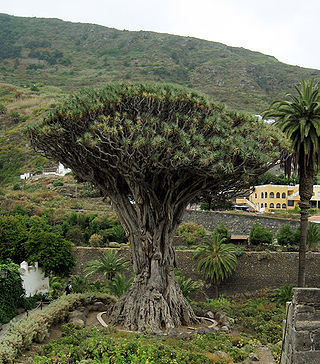
Dracaena draco, the Canary Islands dragon tree or drago, is a subtropical tree in the genus Dracaena, native to the Canary Islands, Cape Verde, Madeira, western Morocco, and possibly introduced into the Azores.

Laurus is a genus of evergreen trees or shrubs belonging to the laurel family, Lauraceae. The genus contains three or more species, including the bay laurel or sweet bay, L. nobilis, widely cultivated as an ornamental plant and a culinary herb.
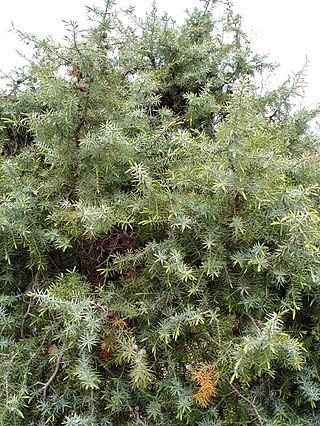
Juniperus oxycedrus, vernacularly called Cade, cade juniper, prickly juniper, prickly cedar, or sharp cedar, is a species of juniper, native across the Mediterranean region, growing on a variety of rocky sites from sea level. The specific epithet oxycedrus means "sharp cedar" and this species may have been the original cedar or cedrus of the ancient Greeks.

Picconia is a genus of two species of flowering plants in the family Oleaceae, found in the laurel forests habitat of Macaronesia.
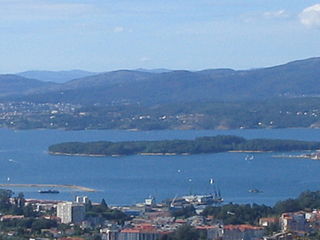
Cortegada is an almost tidal island in a coastal inlet near Pontevedra in Galicia, Spain. It is part of the Atlantic Islands of Galicia National Park.
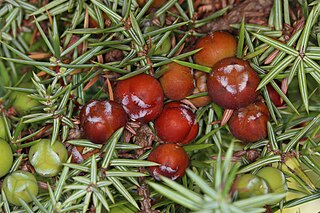
Juniperus deltoides, the Eastern prickly juniper, is a species of juniper native to the eastern Mediterranean. Although it is sometimes considered a subspecies of Juniperus oxycedrus, phylogenetic studies have found the two are not closely related.
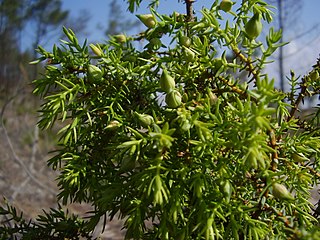
Juniperus navicularis, the Portuguese prickly juniper, is a species of juniper endemic to the southwestern Iberian Peninsula. Although it is sometimes considered a subspecies of the Mediterranean Juniperus oxycedrus, phylogenetic studies have found the two are not closely related.
Pico da Vara is the highest mountain on the island of São Miguel, in the Portuguese archipelago of the Azores, and principal special protection of the Nature Reserve of Pico da Vara. The area around the mountain includes the largest remaining stand of the native laurisilva forest on the island, home to the critically endangered endemic Azores bullfinch.

The Botanical Garden of Faial is an ecological garden, component of the Faial Nature Park, established in 1986 to educate and protect the biodiversity common on Faial, an island of the Azores archipelago.

The Azores wood pigeon, Columba palumbus azorica is an endemic subspecies of the common wood pigeon, located in the Atlantic Azores islands of Portugal. This endemic subspecies is the only live pigeon present in the laurel forest habitat of the Azores Islands.
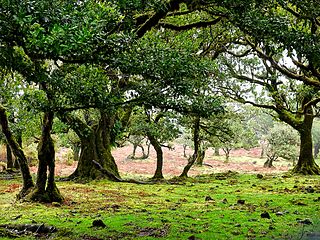
The Madeira evergreen forests is a laurissilva ecoregion of southwestern Europe. It covers the archipelago of Madeira and some nearby islands in the Atlantic Ocean. Laurel forest, known as Laurisilva of Madeira, once covered the islands. Over centuries the laurel forests were mostly cleared. Madeira's remaining forests are now protected.

The Azores temperate mixed forests is a temperate broadleaf and mixed forests ecoregion of southwestern Europe. It encompasses the Azores archipelago in the Atlantic Ocean. These volcanic islands are an autonomous region of Portugal, and lie 1500 km west of the Portuguese mainland.
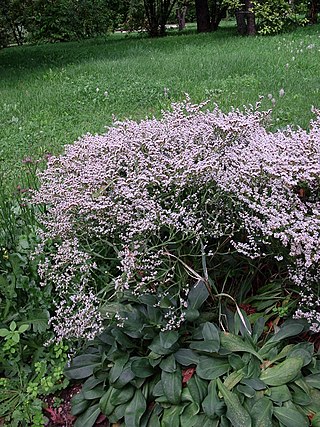
Goniolimon, sometimes called the statices, are a genus of flowering plants in the leadwort and plumbago family Plumbaginaceae, native to northern Africa, southern Europe, western and central Asia, Siberia, Mongolia and China. Low-lying perennial shrubs, some species are cultivated as ground covers.
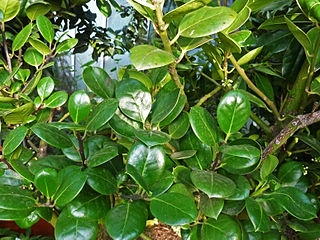
Ilex perado, the Macaronesian holly, is a species of holly endemic to Macaronesia, distributed throughout the Azores, Madeira and Canary islands. It is an important component of the natural high-altitude Macaronesian rainforest, known as 'laurisilva', found mostly at 500 to 1,200 m altitude but it also appears in forest formations at lower elevation. Many of the subspecies have been classified as threatened, probably because of very small population sizes, and are protected by local, national and regional legislation.
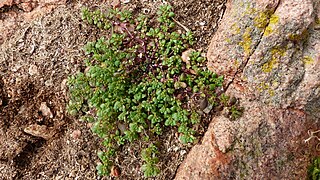
Herniaria lusitanica is a species of flowering plant in the family Caryophyllales. It is endemic to the Iberian Peninsula and the Berlengas archipelago.

Limonium bonduellei, the yellow statice, is a species of flowering plant in the family Plumbaginaceae. The Global Biodiversity Information Facility calls it Algerian statice and lists it as Limonium sinuatum subsp. bonduellei, but a 2018 molecular study showed that it is good species with 100% bootstrap support. An annual facultative halophyte reaching 50 cm (20 in), it is native to Spain and North Africa, and has been introduced to Italy. It is naturalized in New Zealand.





















